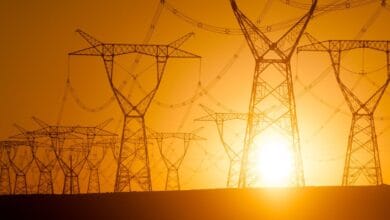Dynamic Line Rating: Fixing Grid Congestion Efficiently
▼ Summary
– Technicians use drones to install Heimdall Power’s metal orbs on transmission lines to monitor real-time environmental conditions and optimize line capacity without requiring electrical downtime.
– Dynamic Line Rating (DLR) allows grid operators to maximize transmission line capacity by using real-time weather data, addressing grid congestion more effectively than traditional static line ratings.
– Heimdall Power’s system tracks metrics like line sag, ambient temperature, and sunlight intensity, combining them with weather forecasts to improve grid planning and efficiency.
– Companies like Linevision and Gridraven offer alternative DLR solutions, using lidar sensors and machine learning for wind predictions to increase line capacity by up to 30%.
– While DLR provides a cost-effective short-term solution for grid congestion, long-term infrastructure expansion is still needed to meet growing energy demands from AI, electrification, and renewables.
On a brisk afternoon near Hamburg, a team of engineers carefully maneuvers a metallic sphere beneath a humming 110-kilovolt transmission line. This unassuming device, resembling a high-tech bowling ball, represents a breakthrough in modern grid management. Within minutes, a drone lifts it into position where it snaps onto the power line, no shutdown required, beginning its mission to revolutionize how we transmit electricity.
This innovative approach, known as dynamic line rating (DLR), is transforming power grids worldwide by unlocking hidden capacity in existing infrastructure. Traditional methods rely on static ratings based on worst-case seasonal assumptions, forcing utilities to operate lines far below their true potential. Modern sensor systems now track real-time conditions, from wire temperature to wind patterns, allowing grid operators to safely maximize throughput when environmental factors permit.
Heimdall Power, the Norwegian company behind these spherical sensors, has deployed over 200 units across northern Germany. Their “Neuron” devices measure critical variables like line sag and ambient temperature, feeding data into algorithms that calculate precise capacity limits. The system even incorporates weather forecasts to help utilities plan power flows a day in advance. During a Minnesota pilot project, utility Great River Energy reported capacity boosts of 25% during nearly 70% of operating hours.
The urgency for such solutions has never been greater. With global electricity demand surging from data centers, electrification, and renewable energy projects, grid congestion has become a multi-billion-dollar bottleneck. Building new transmission lines often takes a decade or more, making DLR and other grid-enhancing technologies (GETs) essential stopgaps. Industry experts estimate these solutions could defer billions in infrastructure costs while accelerating renewable integration.
Different companies employ varied technical approaches. Boston-based Linevision uses tower-mounted lidar sensors, technology refined by the autonomous vehicle industry, to monitor line sag without direct contact. Their systems combine detailed terrain mapping with machine learning to predict how local wind patterns affect cooling. In one UK deployment, National Grid achieved 31% average capacity increases, saving customers £14 million annually.
Estonian startup Gridraven takes a software-focused approach, using AI to create hyperlocal wind models without physical sensors. Their system analyzes satellite and lidar terrain data to predict how landscape features alter wind flow near power lines, a factor responsible for two-thirds of forecasting errors. Currently rolling out across Finland’s high-voltage network, their solution demonstrates how computational power can extract more value from existing assets.
While DLR offers immediate relief, experts emphasize it’s not a permanent fix. Grid congestion costs U.S. consumers $12-21 billion yearly, underscoring the need for both short-term optimizations and long-term infrastructure expansion. Advanced reconductoring projects can double line capacity but require costly downtime. By contrast, DLR implementations often pay for themselves within months through reduced congestion fees and deferred capital expenditures.
“The beauty of dynamic line rating lies in its simplicity,” notes a Heimdall executive. “We’re not reinventing the grid, we’re helping operators see what’s always been there.” As renewable generation scales globally, such technologies will prove indispensable for balancing variable supply with growing demand, buying crucial time for the massive grid upgrades our energy transition demands.
(Source: Spectrum)




